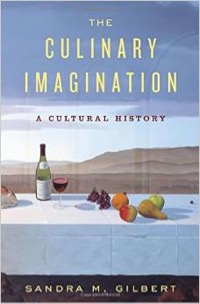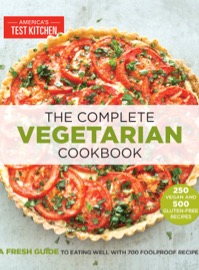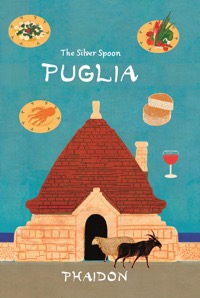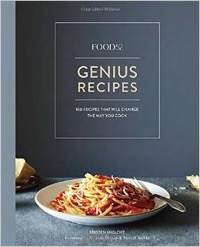New Spring 2015 Cookbooks
Thousands of new cookbooks are published every year. Many thousands. You can't help but wonder what could justify so many new titles. Maybe we home cooks need constant inspiration. Plus when someone has a passion about what they know, they think others might want to know it, too. That's why I wrote my book, so I understand.
But it's also because what we know about food and how we want to eat continues to change. Many of the best selling cookbooks are ones that are more dietary than culinary. Take a look at Amazon's cookbook bestsellers and you'll see that many have either paleo or skinny in their titles (sometimes with a touch of profanity for emphasis), which to me means they are more about how someone might want to eat rather than how they want to cook. There is a difference.
When I start plowing through the new cookbooks that are often sent to me, I try to imagine what you all might want to know so I can best be your proxy. With 24,000 new cookbooks published every year, only a handful make it onto bookstore shelves so I think of myself as browsing on your behalf.
Happily, this spring's crop of titles is full of worthy temptations and there is certainly something for everyone. For those who like to read about food as much (or more) than cook it, a prominent critic and poet has gone to the kitchen to explore how food is at the heart of our cultural identities. Next, one of our most trusted cookbook publishers has produced a superb core work on vegetarian cooking. Another publisher, famed for its beautiful books about heritage cooking, has created a gorgeous volume about the food of Puglia. And finally, a fun, popular website has searched out our best practices, named it genius, and given the trophy to 100 recipes. It is no small feat to finally have a definition for recipe excellence.
The Culinary Imagination
Before turning to the cookbooks, let's begin with The Culinary Imagination: From Myth to Modernity (W.W. Norton, $29.95 hardcover, 404 pages). Sandra M. Gilbert, an author, feminist critic, poet, teacher, and clearly also an enthusiastic eater, has written an engaging and eclectic volume about food writing, cultural identity, and our growing obsession with what we eat -- what she calls the "political and poetical" of food in our lives. If you are a fan of reading cookbooks, food blogs and gastroporn, be prepared for this book's scholarship and literacy. But if you're interested in how food has moved for centuries through our culture, literature, and national mindsets to get us where we are today, Ms. Gilbert's volume will be very satisfying. For me it offered perspective on such phenomena as The Food Network -- it seems we should have seen it coming.
There is a chapter on Julia Child, others on the creation of influential personalities like Deen and Bourdain, food and death, food in art and literature, insights from rituals like White House state dinners and food critics dining in disguise, an occasional recipe and photograph, and other chapters that attempt to explain why, aside from appetite, we are so food obsessed. Culinary Imagination has its share of scholarship (there are 17 pages of footnotes and a bibliography) but in referencing the famous Brillat-Savarin quote, "Tell me what you eat, and I shall tell you what you are," Ms. Gilbert takes a modern step forward by showing us how "what you eat will of course tell me something about you -- but what you watch and read about eating will tell me at least as much."
The Complete Vegetarian Cookbook
In a season when most of the new cookbooks are very auteur, the three I chose to share with you instead come from editor/author collectives.
First up is America's Test Kitchen's The Complete Vegetarian Cookbook. (America's Test Kitchen, $29.95 paperback, 472 pages, color photographs). I am neither a vegetarian nor a vegan but without a doubt, vegetables are my favorite food group. But I've been frustrated as I strive, like many of you, to reduce the amount of animal protein in my diet, because I'm regularly disappointed in vegetarian cooking, finding it elusively unsatisfying.
For me the challenge of vegetarian cooking is to make meals that are satisfying and delicious without feeling like there is always something missing. As if each recipe simply leaves out the meat or fish or chicken and then calls it vegetarian. But when I received a copy of American Test Kitchen's new vegetarian cookbook, I decided to give it a try hoping they would do better. And they do.
In this big paperback volume -- it's a large format at 10 by 8 1/2 inches and big enough for a page to show a whole recipe plus sidebars and photographs -- ATK has managed to create a robust collection of recipes that are both keen to how we eat every day and also put the vegetables front and center. This is no Caesar-salad-leave-off-the-grilled-chicken kind of vegetarian. You won't think anything is missing with such dishes as Vegetable Moussaka, Pinto Bean, Beet and Bulgur Burgers, or Super Greens Soup with Lemon-Tarragon Cream. The 700 recipes are divided among such chapters as Hearty Vegetable Mains; Beans and Soy; Savory Flatbreads, Pizza, Tarts, and More; Small Bites and Savory Snacks; and Eggs for Breakfast and Dinner. The book is full of ATK's expected tips, insights, and lessons, and the 690 color photographs show both plated food as well as close-ups on techniques. Also typical of America's Test Kitchen, you can make almost everything with supermarket-sourced ingredients.
I've made the book's Pimento Cheese Spread (I am a Yankee and not from the south but I thought this was outstanding), Cuban-Style Black Beans and Rice (minus any ham hock but still very flavorful), and Avocado Salad with Tomato and Radish (excellent made with cherry tomatoes but I bet it will be outstanding with summer beefsteaks). I've got about another twenty recipes flagged and I expect this volume will stay in my kitchen and not get relegated to the other bookcase where I park the rarely used cookbooks.
The Silver Spoon's Puglia
Puglia. From The Silver Spoon. (Phaidon, $39.95 hardcover, 272 pages, color photography). And where is Puglia? It's next to Basilicata. Unless you are a hard core Italophile, you might need to look this up on a Google map: Puglia is the heel of the boot and Basilicata is its instep, tucked next to Calabria. This is deep southern Italy, land with mountains, sea coasts, forests, and wheat fields. It is home to some of the best ingredients in the world, especially olives and cheeses, and its flavors come from the cucina povera -- the food of the poor, in which home-grown or local ingredients cooked simply, create satisfying excellence and big-flavored food traditions.
While you might need a map to locate Puglia and Basilicata, you may already know and love its flavors because while many Americans think Tuscany when they think Italy, what they taste are mostly the foods of the south. South of Rome and south of Naples. Here the food is defined by the climate and landscapes as well as the centuries of Greek and North African armies that conquered and settled the areas.
This beautiful book is a hardcover with a dustcover and two placeholder ribbons and 250 gorgeous color photographs of both the food and the breathtaking landscapes. It is divided into eight chapters, one for each province that make up the two sister regions: Foggia, Barletta-Andria-Trani, Bari, Taranto, Brindisi, Lecce, Potenza, and Matera. The 50-plus accessible recipes showcase such ingredients as eggplant, baccala, grains, legumes, lamb, lemons, wild chicory, burrata, and the distinctive hot chili peppers of Basilicata. My favorite recipe so far is a simple one that can be made year-round: Peperoni Verdi Ripieni e Fritti. Stuffed and Fried Green Peppers. It's made with whole sweet, long peppers (easy to find in most grocery stores), stuffed with Parmesan and Pecorino-flavored breadcrumbs, lightly sautéed, and then simmered in a pool of canned chopped tomatoes. It takes less than 30 minutes to make, can be served at room temperature, and the leftovers are divine.
If you are familiar with any of The Silver Spoon cookbooks, this is the latest to join that series. Puglia would make a wonderful gift for anyone who has a passion for Italy and Italian cooking. Or for someone who wants to venture into the kitchens of lesser-known Italian regions.
Food52 Genius Recipes
While this final cookbook indeed has an author in Kristen Miglore, in fact there are 100 others who created the recipes featured in Food52 Genius Recipes: 100 Recipes That Will Change the Way You Cook by Kristen Miglore (Ten Speed Press | Penguin Random House, $35.00 hardcover, 272 pages, color photography).
As many of you may know, Food52 is a terrific and often inspiring recipe/advice/commerce website created by Amanda Hesser (formerly of The New York Times) and Merrill Stubbs. One aspect of Food52 that has always intrigued me is how they combine recipes and cooking advice from a spirited and obviously highly skilled community of home cooks along with others whom they call the geniuses -- very practiced and often famous chefs and food writers (plus in one notable case, the owner of a cookbook bookstore).
In Food52 Genius Recipes, Kristen Miglore, who is an editor at the Food52 website, has chosen 100 of those "genius" recipes -- some described as "legendary" -- and put them together in one lovely volume along with headnotes and tips and "genius technique" sidebars about methods and ingredients.
Most, maybe all (I haven't checked) of these 100 recipes can be currently found at Food52 (go to the site and search for "genius"). So why bother with this book? Because it's not just about the 100 recipes. What is special and learned about this volume, and why many home cooks who are trying to up their game might want to have this in their cookbook collection, has to do with Kristen Miglore's work that surrounds the recipes. The fact is that you can easily elsewhere find Marcella Hazan's famous tomato sauce with onion and butter; but what is really helpful is the headnote that talks about peeling tomatoes and then a sidebar about the three ways to make fresh tomatoes ready for sauce. It's the sidebar that will help you become a better cook and make a better sauce whether it's Marcella's or someone else's. And that's really the point: the geniuses knew these skills and now you can have them, too.
Included in this volume are recipes by Richard Olney, Nigel Slater, Jim Lahey, Dan Barber, Rose Levy Beranbaum, Roy Finamore, Barbara Kafka, Julia Child, and Nobu Matsuhisa and 92 others with recipes from breakfast to dessert. Yes, we love our cooking rock stars, but what makes the book worth having is Ms. Miglore's insight and her using a kind of laser pointer to say to us "this is why this recipe works and this is what you can learn from it and use elsewhere."
Being a lover of actual books and not just web printouts, I certainly appreciate having some of my favorite recipes all in one lovely volume. Back to that bookstore owner. Nach Waxman, owner of Manhattan's Kitchen Arts & Letters, has a recipe for Brisket of Beef that is, to my thinking, without brisket peer. Is it a genius recipe? I think so. Here it is.
Other Spring Cookbooks
As noted earlier, there are about 24,000 cookbooks published each year. Who knows what this roar of recipes says about us, but it certainly makes it tough for new authors to get any airtime and bestseller lists only tell us which have sold, not necessarily which are good. If you're looking for some new inspiration and want ideas beyond the ones I've mentioned here, several other cooking websites have chosen their favorites and I've added links to their lists:
Bon Appetit -- The Best New Cookbooks for Spring 2015
Eater.com -- The Most Anticipated Cookbooks of Winter/Spring 2015
Epicurious -- The Epicurious Spring 2015 Cookbook Preview
Tasting Table -- Best New Cookbooks for 2015
Finally, three other new titles for you to take note of: April Bloomfield's A Girl & Her Greens (Bloomfield also wrote the very successful and award-winning A Girl & Her Pig) is getting high marks and is another one of the new books that is making this cookbook season particularly vegetable-centric.
Peru by Gaston Acurio is one of the first major books on this increasingly popular but long overlooked cuisine.
Melissa Clark recently wrote a detailed and appealing review of Maureen Abood's new Rose Water & Orange Blossoms to which I can only add my genuine enthusiasm and appetite. Inspired by Ms. Abood's splendid blog that showcases the cuisine of Lebanon, both the blog and the book are simply wonderful, tempting, involving and beautiful. Here is a link to Melissa Clark's review with recipes included.
It might technically still be spring but seems like it's okay to call it summer. Enjoy the start of warm weather cooking. And support your local cookbook author and make something new this week.
Kate McDonough
Editor, TheCityCook.com



